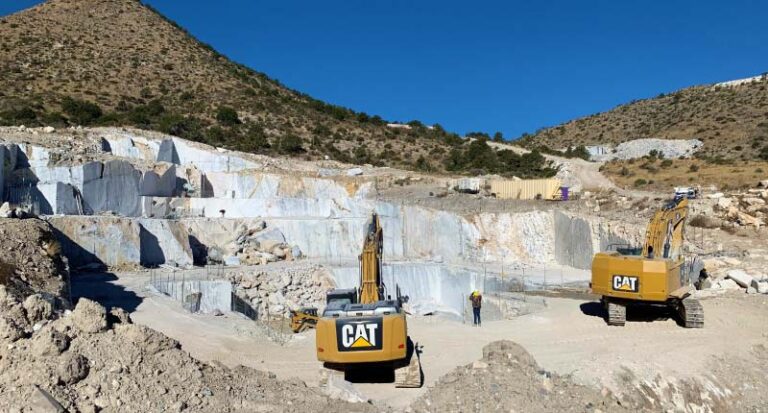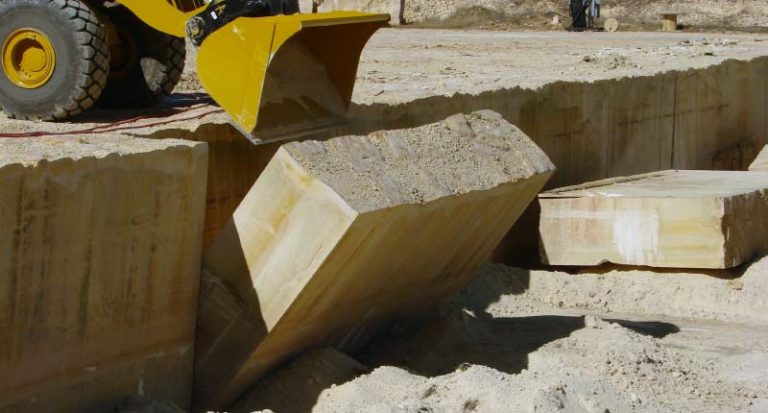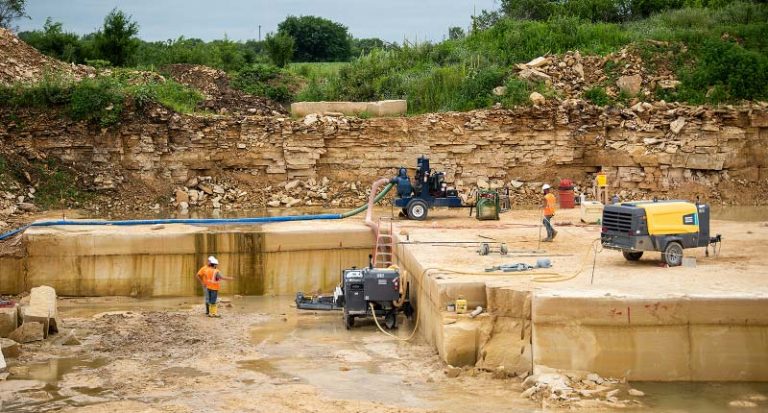
My involvement with the natural stone industry began in a distinct moment in 2012. In the midst of a kitchen remodel, I was browsing kitchen discussions on the Houzz website, learning about grout and cabinet hinges and numerous other topics that suddenly were of urgent importance.

Not too far below the ground, the Yellowstone supervolcano’s persistent geothermal heat stokes iconic geysers, boiling mudpots, and colorful hot springs. A body of magma resides about 3 miles below the surface of Yellowstone National Park. The hot rock warms the groundwater, which then travels upward along faults, dissolving minerals from the surrounding rock as it passes by. By the time the hot water emerges at the surface, it’s laden with minerals. Travertine is the most common type of stone made by hot springs. Calcium carbonate is dissolved from layers of limestone rock below and carried upward. As the water flows out of the earth, it cools down and deposits the minerals. Over time, the flowing hot water leaves behind layer upon layer of newly-formed rock in the artistic pattern that makes travertine so treasured.

Las Vegas isn’t known for its subtlety. But just beyond a city defined by glitz and sparkle, one can experience a whole other color spectrum—one dictated by nature rather than neon lights. The desert offers a dramatic interplay of hues and textures, as canyons and cliffs in shades of russet, mahogany, and bronze echo across the landscape. These iconic rocks are ancient sand dunes that have become frozen in time; a vast deposit of richly-colored stone that has a myriad of uses.

The formation of Dakota Mahogany marks the last time the Midwest endured a tectonic collision. Since then, seas have advanced and retreated across the landscape, the continents have rearranged themselves in different parts of the globe, and vast ice sheets grew, then melted, then grew again, over the course of several ice ages. After 2.6 billion years of erosion, the Midwest’s former mountain ranges have been worn down, leaving the landscape mostly flat. Through all of this, Dakota Mahogany sat patiently, waiting for its day in the sun.

Among sweeps of tan, red, and grey rock sits a surprise: A pocket of gleaming white marble. The Cochise Marble quarry is located near Bowie, AZ in the Chiricahua Mountain range. The original quarry operated for around thirty years, and like so many historical quarries, it shut down, sitting idle for over six decades until local businessman Matt Klump reopened it in 2002.

Vermont Verde’s original quarry is so impressively deep that it’s a tourist attraction. The walls of the quarry are dark green with white veining, and a pool of turquoise water sits at the bottom, 200 feet down.

Berea sandstone is famous for good reason; it’s a durable stone with few irregularities. The sandstone straddles the all-important line of being hard enough to withstand the elements, yet soft enough to be workable.

After being a stone dealer and fabricator for 12 years, Continental Cut Stone entered a new chapter as a quarrier. More than twenty years later, they’ve never looked back.

Much of the stone industry rests on centuries-old quarries with a multi-generational history of operations, but Kasota Stone emerged only seven years ago. Principal founder Jake Barkley and his team bring forth an unusual business model, a collaboration with the State of Minnesota, and a clearly-articulated determination to grow and thrive.

Krukowski Stone Company quarries two distinctly different stone types: Aqua Grantique and Quartz sandstone. Although they are quarried only a mile apart, they’re separated by more than 1 billion years of geologic time.

The team at AM3 offers no shortage of enthusiasm and ambition as they strive to help an American marble reach its full potential.

Thanks in part to labor laws, environmental laws, and unions, American quarries have gradually become less dangerous workplaces with better pay and benefits. The sense of appreciation and trust among the three managers is palpable, and it’s clear they feel a sense of satisfaction in their efforts to make the job better and safer for everyone.

TexaStone taps into 16 individual quarry pits to produce six different varieties of limestone. A 55,000 square-foot fabrication shop sits on the property, equipped with state-of-the art machinery.

Throughout the evolution of this American limestone company, two things have always been in plentiful supply at Vetter Stone: stone and Vetters. And both are here to stay.

Tucked inside Dorset Mountain is the world’s largest underground marble quarry, spanning an area of about 16 football fields and stretching for over a mile – all underground. There’s one entrance to the Vermont Danby quarry, and it’s the same one that’s been in use for over 100 years.

Colorado Marble is prized for the stone’s pure color, pure composition (99.56% calcium carbonate), light veining, and consistency of the pattern throughout the formation. These attributes and beauty – in addition to the sheer quantity of stone present – give Colorado marble a place of prominence in the world market.

The story of Rocky Mountain Quartzite is a classic American success story that brings together all the necessary elements: favorable geology, a product that could distinguish itself from others, and a business plan and workforce that could develop the company to its full potential.

Every block of stone holds a story. Not just in its geologic past, but also in the ways that stone becomes part of human history. Behind every successful quarry is a collaboration between the forces of nature that created the stone, and human inventiveness that built it into a successful venture.

White stones are popular, frequently mislabeled, and often misunderstood. Learn how to tell if your white stone is a granite, quartzite, or marble. White stones are popular, frequently mislabeled, and often misunderstood.

Learn how to test stone samples for hardness, acid resistance, and porosity. Kitchen designers, architects, fabricators, and restoration professionals can use diagnostic techniques to learn as much as they can about particular varieties of natural stone.
